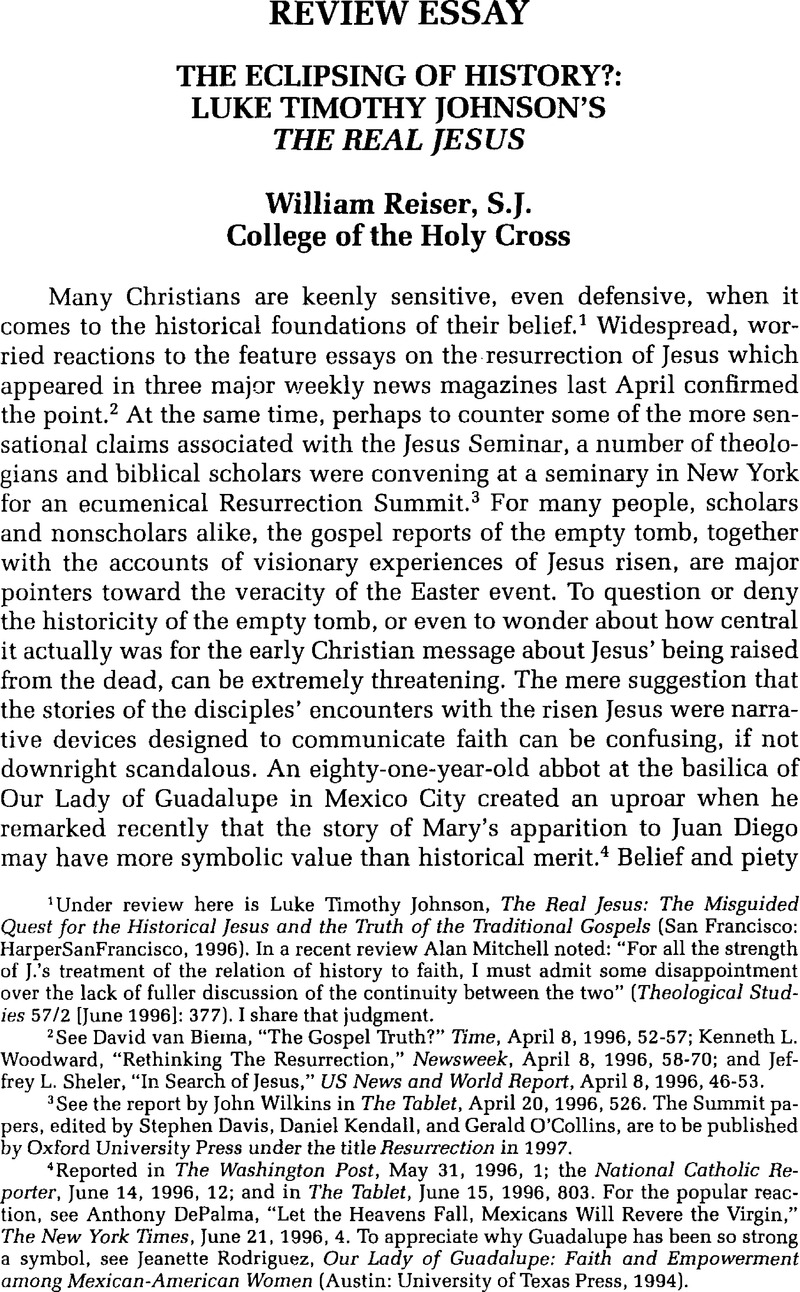No CrossRef data available.
Article contents
The Eclipsing of History?: Luke Timothy Johnson's The Real Jesus
Published online by Cambridge University Press: 09 September 2014
Abstract

- Type
- Review Essay
- Information
- Copyright
- Copyright © The College Theology Society 1997
References
1 Under review here is Johnson, Luke Timothy, The Real Jesus: The Misguided Quest for the Historical Jesus and the Truth of the Traditional Gospels (San Francisco: HarperSanFrancisco, 1996).Google Scholar In a recent review Alan Mitchell noted: “For all the strength of J.'s treatment of the relation of history to faith, I must admit some disappointment over the lack of fuller discussion of the continuity between the two” (Theological Studies 57/2 [06 1996]: 377CrossRefGoogle Scholar). I share that judgment.
2 See van Biema, David, “The Gospel Truth?” Time, 04 8, 1996, 52–57;Google ScholarWoodward, Kenneth L., “Rethinking The Resurrection,” Newsweek, 04 8, 1996, 58–70;Google Scholar and Sheler, Jeffrey L., “In Search of Jesus,” US News and World Report, 04 8, 1996, 46–53.Google Scholar
3 See the report by Wilkins, John in The Tablet, 04 20, 1996, 526.Google Scholar The Summit papers, edited by Davis, Stephen, Kendall, Daniel, and O'Collins, Gerald, are to be published by Oxford University Press under the title Resurrection in 1997.Google Scholar
4 Reported in The Washington Post, 05 31, 1996, 1;Google ScholarPubMed the National Catholic Reporter, 06 14, 1996, 12;Google ScholarPubMed and in The Tablet, 06 15, 1996, 803.Google ScholarPubMed For the popular reaction, see DePalma, Anthony, “Let the Heavens Fall, Mexicans Will Revere the Virgin,” The New York Times, 06 21, 1996, 4.Google Scholar To appreciate why Guadalupe has been so strong a symbol, see Rodriguez, Jeanette, Our Lady of Guadalupe: Faith and Empowerment among Mexican-American Women (Austin: University of Texas Press, 1994).Google Scholar
5 For a fuller and thus more helpful study, see Sanders, E. P., The Historical Figure of Jesus (London: Penguin, 1993).Google Scholar Sanders is more generous in sketching elements of the actual historical narrative beneath the gospels.
6 See Sacrosanctum Concilium, The Constitution on the Sacred Liturgy, #7, in the Documents of the Second Vatican Council.
7 One text of Paul will suffice: “and it is no longer I who live, but it is Christ who lives in me” (Gal 2:20). The indwelling of Jesus within his followers through the Spirit is of course a central theme of the fourth gospel.
8 On the idea of salvation, see Brackley, Dean, Divine Revolution: Salvation and Liberation in Catholic Thought (Maryknoll, NY: Orbis, 1996)Google Scholar, and Ellacuría, Ignacio, “The Historicity of Christian Salvation” in Ellacuría, Ignacio and Sobrino, Jon, eds., Mysterium Liberationis: Fundamental Concepts of Liberation Theology (Maryknoll, NY: Orbis, 1993), 251–89.Google Scholar
9 Brown, Raymond, The Community of the Beloved Disciple (New York: Paulist, 1979).Google Scholar “Yet his entire reconstruction of Johannine ‘history’ rests upon no more solid basis than a series of subjective judgments and suspect methodological presuppostions” (Johnson, , The Real Jesus, 100Google Scholar).
10 Meier, John P., A Marginal Jew: Rethinking the Historical Jesus, vol. 1: The Roots of the Problem and the Person (Garden City, NY: Doubleday, 1991)Google Scholar, and vol. 2: Mentor, Message, and Miracles (Garden City, NY: Doubleday, 1994).Google Scholar See Johnson, , The Real Jesus, 127–33.Google Scholar
11 Lorenzen, Thorwald, Resurrection and Discipleship: Interpretive Models, Biblical Reflections, Theological Consequences (Maryknoll, NY: Orbis, 1995).Google Scholar
12 Sobrino, Jon, Christology at the Crossroads (Maryknoll, NY: Orbis, 1978), chaps. 7-9.Google Scholar
13 In his magisterial study, Jesus: An Experiment in Christology (New York: Seabury, 1979)Google Scholar, Edward Schillebeeckx wrote: “The concrete question with which mankind in history confronts the gospel now is: What do Jesus' message and praxis have to contribute to the overall effort to liberate humanity in the full sense of the term?” (623). Schillebeeckx's positioning of the relation between human history in general and divine salvation proposes in effect some necessary parameters for the conversation between biblical scholarship and theology.
14 “The Jesus to whom Saint Francis of Assisi appealed in his call for a poor and giving rather than a powerful and grasping church was not the Historical Jesus but the Jesus of the Gospels. One must only wonder why this Jesus is not also the ‘real Jesus’ for those who declare a desire for religious truth …” (Johnson, , The Real Jesus, 177).Google Scholar
15 Even prophetic leadership is to some extent “situationist.” I am borrowing the expression from Heifetz, Ronald A., Leadership without Easy Answers (Cambridge: Harvard University Press, 1994), 16.Google ScholarPubMed
16 Horsley, Richard, Galilee: History, Politics, People (Valley Forge, PA: Trinity Press International, 1995).Google Scholar
17 Tracy, David, On Naming the Present: Reflections on God, Hermeneutics, and Church (Maryknoll, NY: Orbis, 1994), 21–22.Google Scholar


